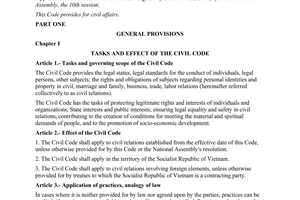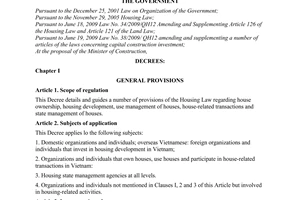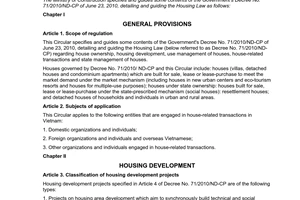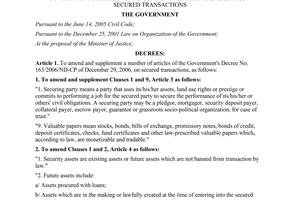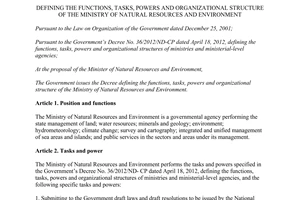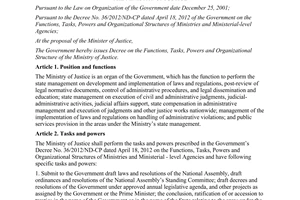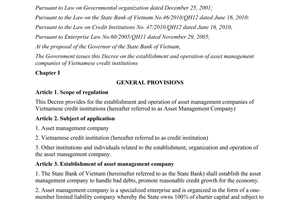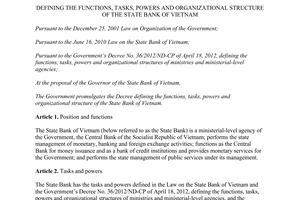Nội dung toàn văn Joint Circular No. 16/2014/TTLT-BTP-BTNMT-NHNN guiding on disposal of security assets
|
THE MINISTRY OF
JUSTICE - THE MINISTRY OF NATURAL RESOURCES AND ENVIRONMENT - THE STATE BANK
OF VIETNAM |
THE SOCIALIST
REPUBLIC OF VIETNAM |
|
Hanoi, June 6, 2014 |
JOINT CIRCULAR
GUIDING A NUMBER OF MATTERS ON DISPOSAL OF SECURITY ASSETS
Pursuant to the June 14, 2005 Civil Code;
Pursuant to the Government’s Decree No. 163/2006/ND-CP of December 29, 2006, on secured transactions;
Pursuant to the Government’s Decree No. 11/2012/ND-CP of February 22, 2012, amending and supplementing a number of articles of the Government s Decree No. 163/2006/ ND-CP of December 29, 2006, on secured transactions;
Pursuant to the Government’s Decree No. 53/2013/ND-CP of May 18, 2013, on the establishment, organization and operation of Vietnam Asset Management Company;
Pursuant to the Government’s Decree No. 22/2013/ND-CP of March 13, 2013, defining the functions, tasks, powers and organizational structure of the Ministry of Justice;
Pursuant to the Government’s Decree No. 21/2013/ND-CP of March 4, 2013, defining the functions, tasks, powers and organizational structure of the Ministry of Natural Resources and Environment;
Pursuant to the Government’s Decree No. 156/2013/ND-CP of November 11, 2013, defining the functions, tasks, powers and organizational structure of the State Bank of Vietnam;
The Minister of Justice, the Minister of Natural Resources and Environment and the Governor of the State Bank of Vietnam promulgate the Joint Circular guiding a number of matters on disposal of security assets.
Chapter I
GENERAL PROVISIONS
Article 1. Scope of regulation
1. This Circular guides the custody and sale of security assets, receipt of security assets as replacement for the performance of obligations of securing parties, and procedures for transfer of asset ownership or use rights after the disposal of security assets.
2. This Circular does not apply to the disposal of security assets in civil judgment enforcement activities.
Article 2. Subjects of application
1. Securing and secured parties to security contracts.
2. Vietnam Asset Management Company established and operating in accordance with Vietnam’s law.
3. Agencies competent to register asset ownership, use rights or circulations rights.
4. People’s Committees of communes, wards or townships (below referred to as commune-level People’s Committees) where security assets are taken into custody.
5. Organizations performing compensation tasks under law in case the State recovers land and land-attached assets.
6. Notarization practice organizations, organizations with the asset auction function, asset lienors, purchasers of security assets, and debt payment obligors.
7. Other related organizations, households and individuals.
Article 3. Responsibilities of related organizations, households and individuals in disposal of security assets
1. To adhere to the principles prescribed in Article 58 of the Government’s Decree No. 163/2006/ND-CP of December 29,2006, on secured transactions (below referred to as Decree No. 163/2006/ND-CP) and Clause 15, Article 1 of the Government’s Decree No. 11/2012/ND-CP of February 22, 2012, amending and supplementing a number of articles of the Government’s Decree No. 163/2006/ND-CP of December 29, 2006, on secured transactions, and other relevant regulations.
2. To implement lawfully established agreements on disposal of security assets, and other relevant regulations.
3. To refrain from obstructing or resisting the lawful custody of security assets; concealing or dispersing security assets or shirking the performance of secured obligations.
Chapter II
DISPOSAL OF SECURITY ASSETS
Article 4. Disposal of mortgaged assets being goods circulated in the production and business process which are sold or replaced by the mortgagor without the mortgagee’s consent while the mortgage contract has been registered as a secured transaction and the mortgagor and mortgagee agree that the mortgagee’s consent is required for the sale or replacement of mortgaged assets
1. In case the mortgagee exercises the right to recover mortgaged assets:
a/ The mortgagee shall send directly or by post to the transferee of asset ownership or use rights a written notice of the recovery of assets, enclosed with one (1) original of the lawfully notarized security contract or one (1) copy of the security contract certified by the commune-level People’s Committee or issued by a notarization practice organization from the original or one (1) copy of the secured transaction registration certificate issued by the secured transaction registration agency;
The above notice must clearly state mortgaged assets, time limit and place for handover and receipt of mortgaged assets, and the entity eligible to receive mortgaged assets;
b/ If the transferee of asset ownership or use rights hands over the assets as requested by the mortgagee, the parties shall make an asset handover record with their signatures and seals (if any);
c/ Expenses related to the preservation of mortgaged assets shall be included in expenses for disposal of security assets. After receiving mortgaged assets, the mortgagee shall preserve them and shall, if causing loss of or damage to mortgaged assets, pay compensation to the mortgagor, except loss or damage occurring before the mortgagee recovers mortgaged assets or due to force majeure events;
d/ If the transferee of asset ownership or use rights fails to hand over the assets as requested by the mortgagee, the latter may take the security assets into custody under Article 63 of Decree No. 163/2006/ND-CP or initiate a lawsuit in accordance with the civil procedure law.
2. In case the mortgagee does not exercise the right to recover mortgaged assets under Clause 1 of this Article:
a/ In case the mortgagor sells mortgaged assets, the mortgagee may request the mortgagor to transfer the proceeds from the sale or assets formed from such proceeds for payment of the value of the obligation agreed in the mortgage contract. If the mortgagor has not received any payments yet or has received only part of payments, the mortgagee may request the purchaser to pay for the sale of mortgaged assets.
In case the proceeds from the sale of mortgaged assets or the value of assets formed from such proceeds are/is insufficient for payment of the value of the agreed obligation, the mortgagor shall pay the deficit to the mortgagee if the mortgagor is concurrently the party with secured obligation, or the party with secured obligation shall pay the deficit to the mortgagee if the mortgagor is not concurrently the party with secured obligation, unless otherwise agreed by the parties;
In case the proceeds from the sale of mortgaged assets or the value of assets formed from such proceeds are/is larger than the value of the agreed obligation, the mortgagee shall return the difference to the mortgagor;
b/ In case the mortgagor replaces mortgaged assets, the mortgagee may take into custody and dispose of the replacing assets and the amount paid for the value difference (if any) for payment for the mortgagor’s obligation.
3. The mortgagee that cannot exercise the right to recover mortgaged assets due to their loss, damage or devaluation may request the mortgagor to repair or supplement such assets or replace them with other assets of equivalent value or to supplement and replace with other security measures or claim compensation in accordance with law, unless otherwise agreed by the parties.
4. The transferee of asset ownership or use rights may initiate a lawsuit to request the mortgagor to refund the amount or return the assets received and pay compensation and arising expenses (if any) in accordance with law.
Article 5. Request for return of security assets under lien under bilateral contracts for disposal
1. In case mortgaged assets are under lien under Article 416 of the 2005 Civil Code, the mortgagee may request the mortgagor to perform the obligation toward the lienor or may him/her/itself perform the obligation toward the lienor in order to receive the mortgaged assets. After the mortgagee or mortgagor has fulfilled his/her/its obligation, the lienor shall hand over the assets within the time limit and at the place requested by the mortgagee or the mortgagor.
A written record must be made on the handover of mortgaged assets, bearing the signatures and seals (if any) of the mortgagor and lienor in case the mortgagor performs the obligation toward the lienor, or bearing the signatures and seals (if any) of the mortgagee and lienor in case the mortgagee performs the obligation toward the lienor, unless otherwise agreed by the parties.
The mortgagee that performs the obligation toward the lienor may request the mortgagor to refund the value of the performed obligation and arising reasonable expenses (if any) or include such amounts in the value of the mortgagor’s obligation upon disposal of mortgaged assets.
2. When requesting the lienor to hand over the assets for disposal, the mortgagee shall produce the secured transaction registration certificate granted by the secured transaction registration agency or the mortgage contract to prove that such assets are currently used for mortgage, unless otherwise provided by law.
3. In case the mortgagee or the mortgagor has fulfilled his/her/its obligation but the lienor fails to hand over the assets, thus causing damage to the mortgagee, the lienor shall pay compensation in accordance with law.
In case the lienor fails to hand over the assets or pay compensation, the mortgagee or the mortgagor may initiate a lawsuit to request the court to settle the case.
Article 6. Disposal of mortgaged assets being land use rights and land-attached assets in case the mortgage contract is registered before a competent state agency recovers land or assets under law
1. During the formulation of a compensation, support and resettlement plan under the land law, the organization performing compensation tasks shall seek information on land use rights and land-attached assets subject to recovery at the land use rights registration office.
On the basis of mortgage registration contents provided by the land use rights registration office, the organization performing compensation tasks shall notify in writing the mortgagee and mortgagor of the compensation amount, and the time and place for payment of such amount.
2. In case land use rights and land-attached assets are used to secure the performance of an obligation while the mortgagor and mortgagee agree that the mortgagee is eligible to receive the compensation amount or arising benefits related to mortgaged assets in the validity duration of the mortgage contract, the handover and receipt of the compensation amount are as follows:
a/ Within five (5) working days after receiving a notice from the organization performing compensation tasks, the mortgagee shall submit to this organization the following documents:
- One (1) original of the lawfully notarized or certified mortgage contract or one (1) copy of the mortgage contract certified by the commune-level People’s Committee or issued from thơ original by a notarization practice organization;
In case no agreement is made in the mortgage contract, the mortgagee shall submit one (1) written agreement between the mortgagor and mortgagee about the mortgagee’s eligibility to receive the compensation amount;
- One (1) document clearly indicating the value of the obligation secured by assets recovered at the time the State recovers land use rights and land-attached assets.
b/ Within ten (10) days after receiving a written request for payment of the compensation amount from the mortgagee, the organization performing compensation tasks shall issue to the mortgagor a written notice of his/her/its payment of the compensation amount to the mortgagee. This notice must clearly state the date, hour, compensation amount, name and address of the mortgagee eligible to receive the compensation amount;
c/ The organization performing compensation tasks shall pay the compensation amount to the mortgagee in accordance with the land law and regulations on secured transactions.
If the compensation amount is larger than the value of the payment obligation, the organization performing compensation tasks shall pay the difference to the mortgagor; if the compensation amount is insufficient for payment of the value of the mortgagor’s obligation, the mortgagor shall refund the deficit to the mortgagee, unless the mortgagor is not concurrently the party with secured obligation or unless otherwise agreed by the parties.
3. If the parties do not agree on the mortgagee’s eligibility to receive the compensation amount and arising benefits related to mortgaged assets in the validity duration of the mortgage contract, only after obtaining the mortgagor’s written consent shall the organization performing compensation tasks pay the compensation amount under Clause 2 of this Article to the mortgagee. If the mortgagor gives no consent, the organization performing compensation tasks shall transfer the compensation amount into its bank account and pay this amount after a competent state agency issues a legally effective judgment or decision on dispute settlement, unless otherwise agreed by the parties.
4. In case land use rights and land-attached assets are used to secure the performance of different obligations at different secured parties, the organization performing compensation tasks shall, based on information on mortgage registration contents provided by the land use rights registration office, pay compensation amounts to these secured parties in the order of payment priority corresponding to the values of secured obligations in accordance with the 2005 Civil Code.
5. In case the mortgagor receives compensation in resettlement houses or residential land, such houses or land may be used as replacement for mortgaged assets recovered by the State, unless otherwise agreed by the parties.
During the disposal of security assets, if the value of resettlement houses or residential land is insufficient for payment of the value of obligations, the mortgagor shall pay the deficit to the mortgagee in case the mortgagor is concurrently the party with secured obligation, or the party with secured obligation shall pay the deficit to the mortgagee in case the mortgagor is not concurrently the party with secured obligation, unless otherwise agreed by the parties.
In case the value of resettlement houses or residential land is larger than the value of the mortgagor’s obligation, the mortgagee shall pay the difference to the mortgagor.
Article 7. Disposal of mortgaged assets being the right to claim debts
1. At least seven (7) working days before the time of handling the right to claim debts, the mortgagee shall send to the debt payment obligor a written notice of handling the right to claim debts and one (1) copy of the notarized contract on mortgage of the right to claim debts, certified by a notarization practice organization, or the original contract on mortgage of the right to claim debts with the signatures and seals (if any) of the parties or the certificate of registration of transactions secured by the right to claim debts, granted by the secured transaction registration agency.
2. Within seven (7) working days after receiving the above notice, the debt payment obligor shall pay the debt amount to the mortgagee according to the following guidance:
a/ If the time for performing the debt payment obligation under the contract with grounds for the mortgagor’s right to claim debts to arise is before the time for handling the right to claim debts under the mortgage contract, the debt payment obligor shall transfer the debt amount into the debt payment obligor’s account opened at a bank designated by the mortgagee;
The mortgagee may request the bank to block this account and release it for handling only when the time for disposal of mortgaged assets becomes due. From the time of depositing money into the account, the debt payment obligor may not request the bank to release and conduct any transactions for the deposited amount;
b/ If the time for performing the debt payment obligation under the contract with grounds for the mortgagor’s right to claim debts to arise is after the time for handling the right to claim debts under the mortgage contract, the mortgagee may request the debt payment obligor to pay the debt amount at the time the debt payment obligation becomes due;
The mortgagee may not request the mortgagor to make payment when the debt payment obligation does not become due yet, unless otherwise agreed upon.
3. In case of directly receiving money amounts or assets from the debt payment obligor, the mortgagee shall make a written record and have it signed by the mortgagor, mortgagee and debt payment obligor. This written record must clearly state the handover and receipt of money amounts or assets and determine the value of assets.
This record only needs the signatures of the mortgagee and debt payment obligor if the mortgagor refuses to sign it. The mortgagee shall send the written record to the mortgagor.
4. If the debt payment obligor fails to comply with Clause 2 of this Article, the mortgagee may take the following measures:
a/ Taking the security assets into custody for disposal according to the procedures specified in Article 63 of Decree No. 163/2006/ND-CP in case the debt is in kind;
b/ Requesting the obligor to pay the principal, interest and late payment interest (if any) as agreed in the contract in accordance with law, unless otherwise agreed upon;
c/ Requesting the mortgagor to further perform the security obligation in case the value of the debt payment obligor’s obligation under the contract with grounds for the right to claim debts to arise is insufficient for payment of the value of the mortgagor’s obligation;
d/ Initiating a lawsuit to request the court to settle disputes in accordance with law.
5. The disposal of mortgaged assets being the rights to assets arising from contracts on purchase and sale of future houses must comply with Clauses 1, 2 and 3 of this Article.
Article 8. Disposal of security assets being future assets
1. Security assets which are subject to registration of ownership or circulation rights shall be disposed of as follows:
a/ In case the mortgagor fails to perform or properly perform the obligation agreed in the mortgage contract, resulting in the disposal of mortgaged assets being future commercial houses purchased by organizations or individuals from real estate businesses, mortgaged assets shall be disposed of as follows:
If the investor has not handed over houses to the mortgagor, the mortgagee may receive the mortgaged assets as replacement for the performance of the mortgagor’s obligation under Article 11 of this Circular, or transfer the contract on purchase and sale of future houses to a third party according to the procedures specified in the Government’s Decree No. 71/2010/ND-CP of June 23, 2010, detailing and guiding the Housing Law (below referred to as Decree No. 71/2010/ND-CP) and the Ministry of Construction’s Circular No. 16/2010/TT-BXD of September 1, 2010, specifying and guiding a number of provisions of the Government’s Decree No. 71/2010/ND-CP of June 23, 2010, detailing and guiding the Housing Law (below referred to as Circular No. 16/2010/TT-BXD) In case of receiving the mortgaged assets as replacement for the performance of the mortgagor’s obligation, the mortgagee shall comply with Clause 3, Article 132 of the 2010 Law on Credit Institutions;
If the investor has handed over houses to the mortgagor but has not carried out procedures for grant of a certificate of house ownership, a competent state agency shall grant such certificate to the purchaser in case such houses are sold to pay for the secured obligation. The procedures for grant of a certificate of house ownership must comply with regulations on grant of certificates of land use rights and ownership of houses and other land-attached assets;
b/ In case the mortgagor fails to perform or properly perform the obligation agreed in the mortgage contract, resulting in the disposal of mortgaged assets being future social houses, mortgaged assets shall be disposed as follows:
If the investor has not handed over houses to the mortgagor, the mortgagee shall coordinate with the investor in terminating the house purchase and sale contract with the mortgagor for re-sale of such houses to entities eligible to purchase social houses in accordance with the housing law;
If the investor has handed over houses to the mortgagor but has not carried out procedures for grant of a certificate of house ownership, the mortgagee shall coordinate with the investor in re-selling such houses to entities eligible to purchase social houses in accordance with the housing law;
House purchase and sale procedures must comply with Decree No. 71/2010/ND-CP and Circular No. 16/2010/TT-BXD;
c/ In case the securing party fails to perform or properly perform the obligation agreed in the security contract, resulting in the disposal of security assets which are not specified at Points a and b, Clause 1 of this Article, security assets shall be disposed of as follows:
If the securing party is the purchaser to the asset purchase and sale contract, the secured party may dispose of the assets as agreed in the contract and under regulations of secured transactions. The secured party (in case of receiving the security assets as replacement for the performance of the securing party’s obligation) or the purchaser of security assets may request the seller of security assets to hand over the assets under the asset purchase and sale contract when such assets have been formed;
The seller of security assets shall hand over the assets as requested by the secured party or the purchaser of security assets. Upon requesting the seller of security assets to hand over the assets, the secured party or the purchaser of security assets shall produce the security contract to prove that such assets have been used to secure the performance of civil obligations. A written record shall be made on the handover of security assets, bearing the signatures and seals (if any) of the secured party or purchaser of security assets and the seller of security assets.
In case the seller of security assets fails to hand over the formed assets to the secured party or the purchaser of security assets, the latter may take the formed assets into custody under Article 63 of Decree No. 163/2006/ND-CP or initiate a lawsuit to request the court to settle the case in accordance with law.
The securing party that is the asset manufacturing party shall transfer the formed assets and relevant legal dossiers to the secured party or the purchaser of security assets. A written record must be made for such transfer, bearing the signatures and seals (if any) of the secured party or purchaser of security assets and the securing party.
d/ The registration of asset ownership and circulation rights after the assets are formed must comply with law and the security contract without requiring a written authorization of the securing party.
2. In case the securing party fails to perform or properly perform the obligation agreed in the security contract, resulting in the disposal of future security assets which are not subject to registration of asset ownership, use rights or circulation rights, security assets shall be handled as follows:
a/ The secured party (in case of receiving the security assets as replacement for the performance of the securing party’s obligation) or the purchaser of security assets may own security assets at the time of disposal of such assets, unless otherwise agreed by the parties. The security contract and written record on the disposal of security assets (if any) are used to prove that the secured party may exercise the rights and conduct the transactions related to the assets.
Article 9. Responsibilities of commune-level People’s Committees in exercising the right of security asset disposers to take security assets into custody
1. At least seven (7) working days before taking security assets into custody, security asset disposers may send a written notice of the custody of security assets to commune-level People’s Committees of localities where security assets are taken into custody.
This notice shall be sent directly or by post, enclosed with one (1) copy of the security contract or written agreement on the disposal of security assets concluded lawfully by the parties. The notice must clearly state the reason, time and place for disposal of security assets, the asset custody plan and assets to be taken into custody.
2. After receiving such notice from security asset disposers, commune-level People’s Committees shall promptly take the measures specified in Clause 5, Article 63 of Decree No. 163/2006/ND-CP and Article 30 of the Government’s Decree No. 53/2013/ND-CP of May 18, 2013, on the establishment, organization and operation of Vietnam Asset Management Company.
Article 10. Sale of security assets not through auction
1. In case the securing party and secured party agree on the sale of security assets not through auction and have no other agreements on the determination of sale prices of the assets, the sale prices of security assets shall be determined as follows:
a/ The secured party and securing party shall reach written agreement on the sale prices of security assets. If they fail to reach any agreement, within fifteen (15) days from the date of such failure, the securing party may designate a price appraisal agency or organization to determine the sale prices of assets. Past this 15-day time limit, if the securing party fails to designate a price appraisal agency or organization, the secured party may designate a price appraisal agency or organization to determine the sale prices of assets. Expenses for hiring price appraisal agencies or organizations shall be included in expenses for disposal of security assets;
b/ In case security assets cannot be sold at the prices determined by the price appraisal agency or organization, within fifteen (15) days from the date of failure to sell the assets, the secured party may reduce the sale prices of assets. Such reduction may be made three (3) times, with each reduction not exceeding ten percent (10%) of the determined prices and the interval between two reductions being at least thirty (30) days, for immovable assets, or at least fifteen (15) days, for movable assets. The secured party shall notify the securing party of the reduction of the sale prices of security assets;
If security assets cannot be sold even after three (3) reductions of their sale prices, the secured party may receive the security assets as replacement for obligation performance under Article 11 of this Circular. In this case, the value of security assets is the price of the final reduction, unless otherwise agreed upon by the parties.
2. The sale of security assets must comply with the 2005 Civil Code and other relevant legal documents. The secured party shall pay compensation for its violations of law causing damage to asset owners and persons with rights and benefits related to security assets during the sale of security assets.
Article 11. Receipt of security assets as replacement for performance of the securing party’s obligation
In case the secured party and securing party agree on the disposal of security assets by receiving the security assets as replacement for performance of the securing party’s obligation:
1. The valuation of security assets must comply with Point a, Clause 1, Article 10 of this Circular.
2. In case security assets are subject to registration of ownership or use rights under law, after the disposal thereof, the secured party shall submit the dossier for transfer of ownership or use rights under Clause 1 or 2, Article 12 of this Circular. The security contract or another written agreement on the receipt of the security assets as replacement for performance of the securing party’s obligation shall be used as replacement for the contract and documents on transfer of ownership or use rights of security assets.
3. In case security assets are not subject to registration of ownership or use rights under law, after the disposal thereof, the secured party may own such assets under Clause 3, Article 12 of this Circular.
4. The value of security assets shall be cleared against the loan and interest arising from the credit contract and other reasonable expenses in accordance with law. The securing party may receive the remainder after having made full payment to the secured party.
In case the value of security assets is insufficient for payment of the value of obligations, the securing party shall refund the deficit to the secured party if the securing party is concurrently the party with secured obligation, or the party with secured obligation shall refund the deficit to the secured party if the securing party is not concurrently the party with secured obligation, unless otherwise agreed by the parties.
5. In case the secured party receives the security assets which are ineligible for establishment of ownership or use rights under law, the securing party and secured party may agree to select another method of disposing of security assets prescribed in Article 59 of Decree No. 163/2006/ND-CP The contents of agreement between the parties may be recorded in a separate document or stated in the security contract.
Article 12. Procedures for transfer of asset ownership or use rights after disposal of security assets
1. The dossiers and procedures for transfer of ownership or use rights of security assets being land use rights and land-attached assets after disposal must comply with the land law.
2. When carrying out procedures for transfer of land use rights and ownership of land- attached assets under Clause 1 of this Article and other assets subject to registration of ownership or circulation rights under law, organizations, households or individuals shall submit contracts and documents proving the transfer of asset ownership or use rights, unless they receive the security assets as replacement for the performance of the secured obligations under Clause 2, Article 11 of this Circular.
In case the securing party fails to voluntarily sign the contract and documents proving the transfer of asset ownership and use rights, the secured party may sign them but shall add in the dossier for transfer of asset ownership and use rights one (1) original of the lawfully notarized or certified security contract or one (1) copy of the security contract certified by the commune-level People’s Committee or issued from the original by a notarization practice organization, or another document proving the agreement that the secured party may sign contracts and documents on transfer of ownership and use rights of security assets.
3. In case assets are not subject to registration of ownership and use rights under law, the purchaser and recipient of the security assets may own the assets under Clause 1, Article 439 of the 2005 Civil Code. The lawful security contract and the written record on the disposal of security assets (if any) are documents proving the establishment of the secured party’s ownership over assets.
4. In case of disposal of future assets, if, at the time of disposal, such assets have been formed and are subject to registration of ownership and use rights, the purchaser of security assets shall submit a dossier for transfer of asset ownership and use rights under Clauses 1 and 2 of this Article and other relevant regulations.
5. The transfer of land use rights and ownership of assets shall be conducted concurrently with the deregistration of secured transactions as follows:
a/ If obtaining written consent of the secured party, the securing party may request notarization or certification of contracts and transactions on transfer of ownership and use rights of assets prior to deregistration of secured transactions for such assets;
b/ A dossier for adjustment of changes in land users and owners of security assets shall be submitted concurrently with a dossier for deregistration of security transactions for a competent registration agency to adjust the changes concurrently with the deregistration of secured transactions according to law-prescribed procedures.
6. In case mortgaged assets after investment see changes compared to their descriptions in the mortgage contract and are subject to registration of ownership and use rights under law, the mortgagor shall carry out law-prescribed procedures for certification of the changes in mortgaged assets or for registration of changes at a competent state agency. Ten (10) days after such changes occur, if the mortgagor fails to carry out procedures for certification of the changes in the assets or for registration of the changes at a competent state agency, the mortgagee may still dispose of the mortgaged assets and carry out procedures for certification of changes or registration of changes concurrently with procedures for registration of the transfer of ownership and use rights after the disposal of mortgaged assets.
7. When carrying out procedures for re-grant or renewal of circulation registration certificates for vehicles or transfer of ownership of road and inland waterway motor vehicles which are currently used for mortgage, the agency with vehicle circulation registration competence shall exchange and provide information under Joint Circular No. 15/2013/TTLT-BTP-BGTVT-BTNMT-BCA of November 5,2013, of the Ministry of Justice, the Ministry of Transport, the Ministry of Natural Resources and Environment and the Ministry of Public Security, guiding the exchange and provision of information on security assets between secured transaction registration agencies and notarization practice organizations, civil judgment enforcement agencies and agencies registering ownership, use rights and circulation rights of assets.
Chapter III
IMPLEMENTATION PROVISIONS
Article 13. Effect
This Circular takes effect on July 22, 2014.
Article 14. Implementation responsibility
1. The Ministry of Justice, the Ministry of Natural Resources and Environment and the State Bank of Vietnam shall organize the implementation of this Circular.
2. Chairpersons of provincial-level People’s Committees shall direct lower-level People’s Committees, public security agencies and other related agencies and organizations under their management in actively coordinating with and assisting secured parties in the custody and disposal of security assets and strictly implementing this Circular.
3. The Ministry of Justice shall monitor, summarize and examine the implementation of this Circular. Any problems arising in the course of implementation should be promptly reported to the Ministry of Justice, the Ministry of Natural Resources and Environment and the State Bank of Vietnam for coordinated study and settlement.-
|
FOR THE
MINISTER OF JUSTICE |
FOR THE
MINISTER OF NATURAL RESOURCES AND ENVIRONMENT |
FOR THE
GOVERNOR OF THE STATE BANK OF VIETNAM |
